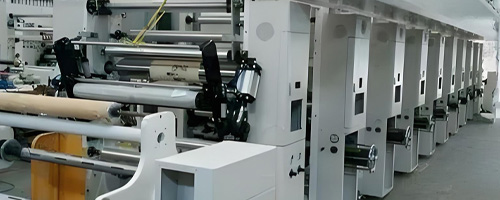 RU
RU
 EN
EN
 CN
CN

Position:HOME > SOLUTION > Offset Printing

Offset printing usually involves three cylinders: plate cylinder, blanket cylinder, and impression cylinder. The printing plate cylinder is attached with graphic and non graphic parts. The graphic part can absorb ink, while the non graphic part absorbs moisture to repel ink. When the printing plate cylinder comes into contact with the blanket cylinder, the ink in the graphic part is transferred to the blanket, and then the blanket cylinder comes into contact with the impression cylinder (carrying the substrate, such as paper), transferring the ink graphic to the substrate and completing the printing process.
In 1904, Caspar Hermann of Germany and Ira Washington Rubel of the United States almost simultaneously began to attempt improvements to lithography technology. In an accidental experiment, Rube discovered an indirect imprinting method, where the image is first transferred from the printing plate to the rubber blanket of the imprinting cylinder, and then printed onto paper. This method produces higher quality printed products. The technology of uniformly transferring ink on the surface of an elastic rubber blanket is the prototype of offset printing technology.
In 1912, the world's first rotary offset printing equipment Universal was introduced, marking the transition of offset printing technology from laboratory to industrial production. The speed of this device has reached 8000 printed sheets per hour, greatly improving printing efficiency.
In the 1920s, offset printing technology was further promoted. These companies have launched their own single sheet and roll offset printing equipment, and developed automated printing equipment with paper transfer units, refrigeration units, folding and drum drying components, etc. Soon, a company launched the world's first four-color single sheet offset press - Planeta Deca, which enables offset printing technology to simultaneously print multiple colors and meets the market's demand for color printed products.
In the 1970s, commercial printing began to develop vigorously, and prepress technology shifted towards automatic high-end color separation technology and full page layout design systems. The application of computers in offset printing and the emergence of film output machines have greatly improved the efficiency of offset printing machines. Printing factories have begun to use computers to control the printing process, and offset printing machines have achieved functions such as ink transfer, plate lubrication, alignment adjustment, and automatic reading of printing plates.

In the realm of newspaper printing, offset printing has consistently played a pivotal role as a traditional yet highly efficient printing method. Newspapers, as crucial mediums for information dissemination
Oct 18 2024

Offset printing technology has been widely used in the field of cardboard box printing due to its bright colors, fine patterns, and high printing efficiency. As an important carrier for product packaging and transportation
Sep 28 2024

Offset printing is a very mature printing method that occupies a pivotal position in the clothing industry with its unique color expression, good durability, and wide applicability. In today's pursuit of individuality,
Sep 28 2024

from advertising to art reproduction, the shadow of offset printing technology is everywhere. Behind all these achievements, a key material is indispensable - offset printing ink.
Sep 24 2024

Offset printing, as a widely used printing technique in the textile industry, holds an important position in various fields such as clothing and home textiles due to its unique color expression and durability
Sep 13 2024

Application of UV offset printing ink on food grade materials
Aug 20 2024